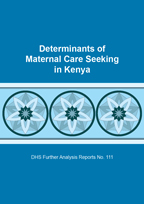
Abstract:
This study is a theory-driven analysis of the
socio-demographic determinants of maternal
care seeking in Kenya. Specifically, it
examines predisposing, enabling, and need
factors potentially associated with use of
antenatal care (ANC), health facility
delivery, and timely postnatal care (PNC).
This study uses data from the 2014 Kenya
Demographic and Health Survey (KDHS)
conducted among women age 15-49 with a live
birth in the five years preceding the survey.
It includes data from all 47 counties of
Kenya, grouped contiguously into 12 regions.
We apply Andersen’s Behavioral Model of
Health Services Use to examine socio-
demographic predictors of health service use.
We estimate logistic regression models for
adequate use of ANC (defined as attending at
least four ANC visits, starting in the first
three months of pregnancy), delivery in a
health facility, and PNC within 48 hours of
delivery.
The odds of adequate ANC are significantly
higher for women with a secondary or higher
level of education, women in the richer and
richest wealth quintiles, and women with low
parity. Compared with the Nairobi region,
women in the Mid Rift region and Nyanza North
region have significantly higher odds of
obtaining adequate ANC.
Delivery in a health facility is
significantly more common among women with
secondary or higher education, women in the
richest wealth quintile, women in urban
areas, women with only one child, women
having no fertility risk, and women who
received adequate ANC. Compared with the
Nairobi region, women’s odds of delivery in a
facility are higher in the Central region and
Upper Eastern region. Significantly lower
odds are found in the Lower Eastern, Upper
Rift, Mid Rift, and Western regions.
Receiving timely PNC—within 48 hours of
delivery—is significantly associated with
women’s level of education. Similarly, women
in the richest wealth quintile have higher
odds of receiving timely PNC. Compared with
the Nairobi region, only Upper Eastern region
and Nyanza North region have significantly
higher odds for PNC within 48 hours. Three
other regions have significantly lower odds
compared with Nairobi: the North Eastern,
Upper Rift, and Western regions. Primiparous
women have higher odds of timely PNC than
women with two or more children. Higher odds
of PNC are also found among women with no
fertility risk compared with those with
fertility risk. Women who received at least
four ANC visits and women who delivered at a
health facility also are significantly more
likely to receive PNC in the 48 hours after
childbirth.
A common set of factors examined in the study
is associated with use of ANC, health
facility delivery, and timely PNC. These
include women’s education (predisposing
factor), wealth quintile and region (enabling
factors), and parity and fertility risk (need
factors). Results also suggest that need
factors, including experience with prior
stages of care, are more prominent than
predisposing and enabling factors in their
influence on maternal care seeking behavior.
 Determinants of Maternal Care Seeking in Kenya (PDF, 2480K)
Determinants of Maternal Care Seeking in Kenya (PDF, 2480K)
 Determinants of Maternal Care Seeking in Kenya (Analysis Brief)
Determinants of Maternal Care Seeking in Kenya (Analysis Brief)
